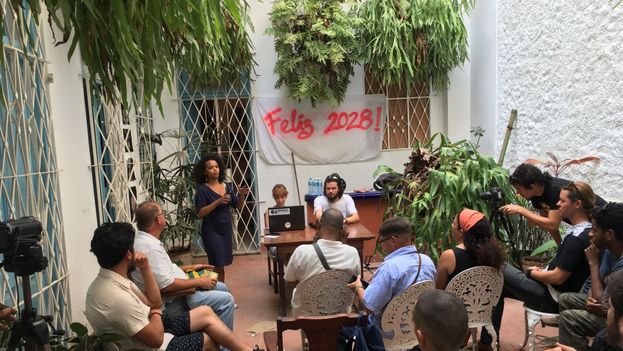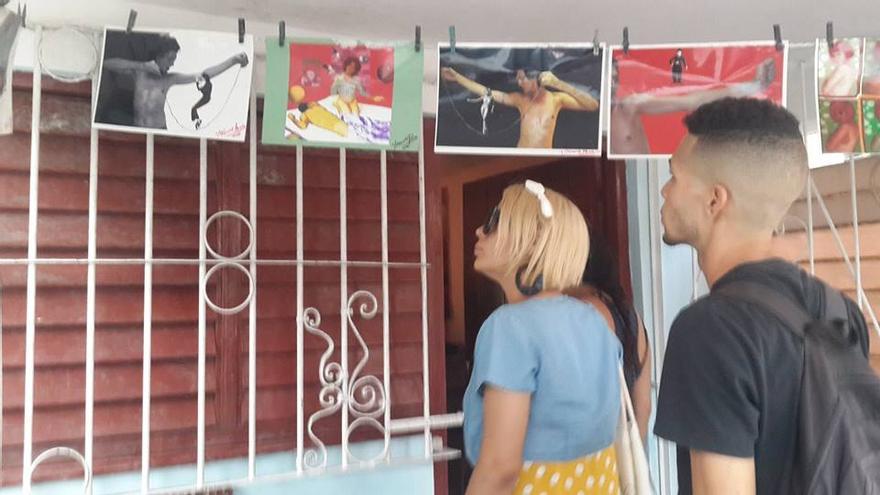
![]() 14ymedio, Luz Escobar, Havana, 15 May 2018 — The #00Bienal has withstood the pressures of the Cuban Government and concluded its first edition on Tuesday, having completed its program despite them. The authorities, who marked the event from the beginning with accusations of it being financed by the “counterrevolution,” have made every effort to prevent the participation of a large number of national and foreign artists, in addition to sending the police to close the exhibition spaces.
14ymedio, Luz Escobar, Havana, 15 May 2018 — The #00Bienal has withstood the pressures of the Cuban Government and concluded its first edition on Tuesday, having completed its program despite them. The authorities, who marked the event from the beginning with accusations of it being financed by the “counterrevolution,” have made every effort to prevent the participation of a large number of national and foreign artists, in addition to sending the police to close the exhibition spaces.
Last Friday the gallery-house El Círculo was the site of the greatest physical repression against the independent Biennial which, until that moment, had been carried out without large police deployments. State Security surrounded the property and prevented public access to the Co-Cina exhibition. An agent who identified himself as Efren even blocked the gallery door. “They did not let anyone in but we have everything filmed,” activist Lia Villares told 14ymedio.
Most of the events of the #00Bienal have been held in artist Tania Brughera’s Instar space in Old Havana, but there have also been events in other Havana municipalities including Marianao, El Vedado, Habana del Este and Santa Cruz del Norte.
In the neighborhood of Alamar, artists Iris Ruiz and Amaury Pacheco have also suffered reprisals for participating in the event. Authorities of the Housing Institute and local government authorities pressured them to stop the painting of several graffiti by the artist Yasser Castellanos, inside and outside their home.
“If we did not stop the work they told us they were going to bring a shock brigade to erase it,” Ruiz tells this newspaper.
However, the employees who arrived to undertake the erasure could not enter the house because the neighbors and friends of the artists supported them “to avoid the outrage. After a while security agents arrived and said that Physical Planning would give us permission to paint,” Ruiz concluded.
“Three months ago everyone thought it would be impossible to stage the #00Bienal,” recalls Luis Manuel Otero Alcántara, one of its main organizers. Among other reasons because “in the Cuban intelligentsia there is a lot of commitment to the system that gives them perks, but also many artists find themselves in a comfort zone that they do not want to leave.”
Despite the wide variety of exhibitions and artistic actions that took place, Otero Alcántara recognizes that “some of the artists announced in the catalog reconsidered a little and have not appeared” due to the harsh accusations that the official institutions launched at the event.
“I’m not a superhero or anything like that,” says the artist, who in recent years has become known for performances like those he held around the luxury hotel Manzana Kempinski, in Old Havana. His artistic actions have aimed to point out the economic gap between nationals and tourists.
“Being an artist is a life position,” confesses the artist, whose greatest current fear is that “the #00Bienal will be shelved within the historical passages” of recent years. “We would like the young filmmakers who recently published a statement to also do an independent film event.”

Threats and interrogations by State Security have been another technique in the attempts made to restrain the participants. Among those affected was the painter Luis Trápaga, removed from the National Artists Registry in retaliation for his involvement in the independent artistic event. The authorities of the National Council of the Plastic Arts, which manage the registry, informed him that the measure was taken because of his position “contrary to the cultural policy of the country.”
The artist José Ernesto Alonso participated in the #00Bienal with a survey that he drew from surveys conducted by international institutions that measure elements such as happiness, satisfaction and well-being in different parts of the world. “I created a guide that allows us to quantify the level of satisfaction that each Cuban has with respect to the current situation of the country.”
Alonso clarifies that “the greatest fear that an artist can have about being part of the #00Bienal is that it all ends up black and white,” and later “they come from the institution and they tell you: if you supported the independent biennial you can not participate in any more of the events we organize.”
Cuban artists such as Hamlet Lavastida and Sandra Ceballos are participate in the event. Ceballos’s independent gallery, Aglutinador, which opened in 1994, is one of the most important venues of the event. The curator Gerardo Mosquera, founder of the Havana Biennial in 1984, has also joined the independent event.
“Some foreign artists, such as the Spaniard Diego Gil, have been summoned by Immigration and they have been told that they can not appear in the Biennial,” says Cuban-American curator and artist Coco Fusco.
Fusco was also prevented on May 3 from entering the country after arriving at the Havana airport. A day later, the artist Gean Moreno, linked to the Institute of Contemporary Art of Miami (ICA), was held for 10 hours in Cuban Customs. Although he was finally able to enter the country, the authorities confiscated the piece with which he intended to participate in the #00Bienal.
The Brazilian artist Thiago Morandi was one of those summoned by the Identification, Migration and Immigration Directorate (DIIE), which demanded that he leave the event, but the photographer and audiovisual producer ignored the threats and continued to appear in the activities of the alternative event.
Ulises Valdés, a Mexican, was also summoned by immigration officials and told to cancel his presence at #00Biennial, but he told the uniformed officers to communicate directly with the consul of his country if there was any irregularity with regards to his presence in Cuba. The officers told him that to be eligible to participate in the event, he would have had to enter the country with a cultural visa.
State Security officials and DIIE members warned foreign participants that they were part of an “unofficial” event that is “financed by the Miami mafia.”
That assertion conflicts with the information provided by the organizers of #00Biennial, who say that all the funding that sustains the event “comes from crowdfunding, which is very transparent” through digital platforms, according to the independent biennial’s curator and organizer, Yanelis Nuñez.
Nuñez and Luis Manuel Otero Alcántara, the main organizers of the event, received important help from the artist Reynier Leyva ‘El Chino’ Novo, who contributed 3,800 CUC from the sale of one of his works to the National Council of the Arts.
The alternative event, which arose after the Ministry of Culture’s announcement that it would postpone the XIII Havana Biennial until 2019, has achieved its initial objective of granting visibility to younger artists, as well as creating a space that promotes debate in an environment of freedom.
_________________________
The 14ymedio team is committed to serious journalism that reflects the reality of deep Cuba. Thank you for joining us on this long road. We invite you to continue supporting us, but this time by becoming a member of 14ymedio. Together we can continue to transform journalism in Cuba.
